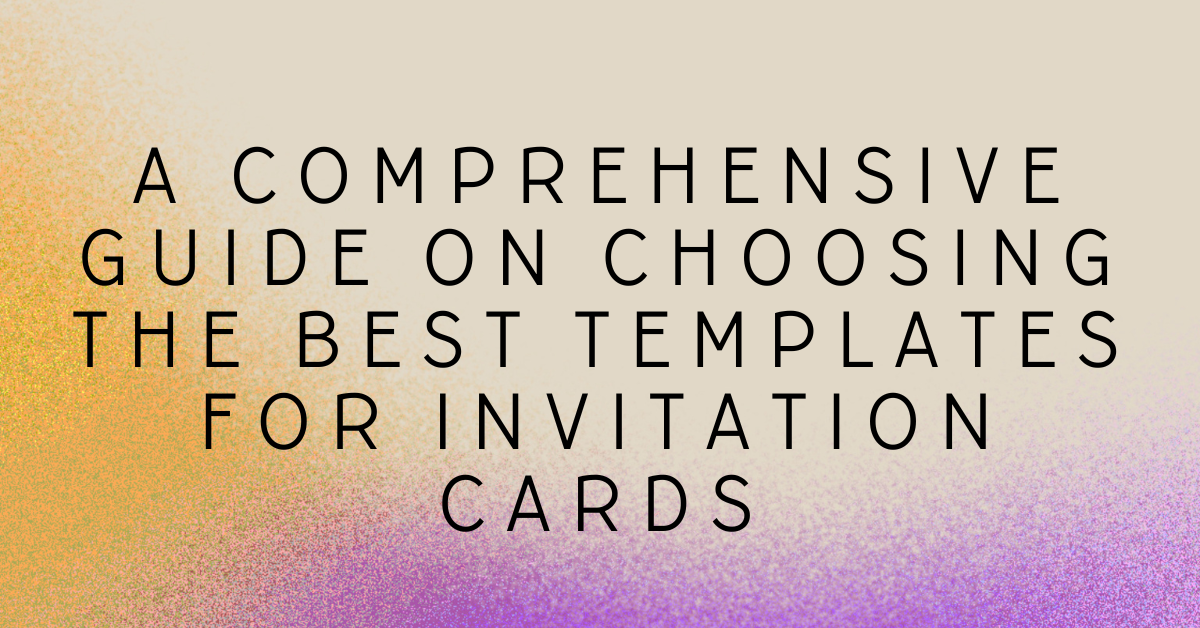A Comprehensive Guide on Choosing the Best Templates for Invitation Cards

Welcome to our comprehensive guide on choosing the best templates for invitation cards. Crafting the perfect invitation sets the stage for any event, and we’re here to navigate you through the intricate process. From design elements to customization options and printing considerations, this article is your roadmap to creating memorable invites. Explore the art of invitation card design and unlock the secrets that transform your events into unforgettable experiences.
Understanding the Purpose of the Invitation
Before delving into the world of templates, it’s crucial to understand the purpose of the invitation. Different events demand different styles, tones, and themes. Is it a formal event like a wedding or a corporate gala, or is it a casual celebration like a birthday or a baby shower? The purpose will guide your template selection process, ensuring that the design aligns with the nature of the event.
Design Elements and Aesthetics
1. Color Scheme
The color scheme sets the overall tone of the invitation. Consider the event theme and the emotions you want to evoke. For formal events, elegant and subdued colors might be appropriate, while vibrant and playful colors work well for casual occasions. Ensure that the chosen colors complement each other and are easy on the eyes.
2. Typography
The font style and size are critical elements in the overall design. Choose fonts that are legible and match the event’s theme. Formal events often call for classic and sophisticated fonts, while informal events allow for more creative and playful choices. Pay attention to font size, ensuring that the text is easy to read.
3. Imagery and Graphics
Selecting the right images or graphics can enhance the overall appeal of the invitation. Consider incorporating relevant symbols or illustrations that resonate with the event. For weddings, floral motifs might be suitable, while birthday invitations could include playful images. Ensure that the graphics do not overpower the text and maintain a balanced visual appeal.
Customization Options
4. Template Flexibility
Choose a template that allows for customization. Flexibility is crucial as it enables you to tailor the design to match your specific requirements. Look for templates that let you easily change colors, fonts, and other design elements. This ensures that the invitation is a true reflection of your event.
5. Personalization
Personalization adds a special touch to invitations. Some templates allow you to include personal details like names, dates, and even photos. This creates a unique and memorable experience for the recipients, making the event more special to them.
Printing Considerations
6. Print Quality
The quality of the final printed invitation depends on the resolution and format of the template. Opt for templates with high resolution to ensure crisp and clear printing. Additionally, choose a template that supports the preferred printing format, whether it’s digital printing, offset printing, or other methods.
7. Paper Selection
The choice of paper can significantly impact the overall look and feel of the invitation. Consider factors such as paper weight, texture, and finish. For formal events, a heavyweight, textured paper may be preferred, while glossy or matte finishes can enhance the visual appeal.
Accessibility and Distribution
8. Digital Accessibility
In the digital age, many invitations are sent electronically. Ensure that your chosen template is adaptable for digital distribution. Check if it can be easily converted into formats suitable for email or social media sharing, maintaining the design integrity.
9. Printing Costs
Printing costs can vary based on factors like color, paper quality, and size. Before finalizing a template, consider the budget for printing and choose a design that aligns with cost constraints without compromising on quality.
Testing and Feedback
10. Mock-Up and Review
Before finalizing the design, create a mock-up or sample of the invitation. This allows you to visualize the end product and make any necessary adjustments. Seek feedback from others to gain different perspectives on the design, ensuring it resonates with a broader audience.
Conclusion
Choosing the best template for invitation cards is a meticulous process that involves considering various design elements, customization options, printing considerations, and practical aspects of distribution. By understanding the purpose of the invitation and carefully evaluating these factors, you can create an invitation that not only communicates essential details but also leaves a lasting impression on your guests. Remember, a well-chosen template is the foundation of a memorable event.





